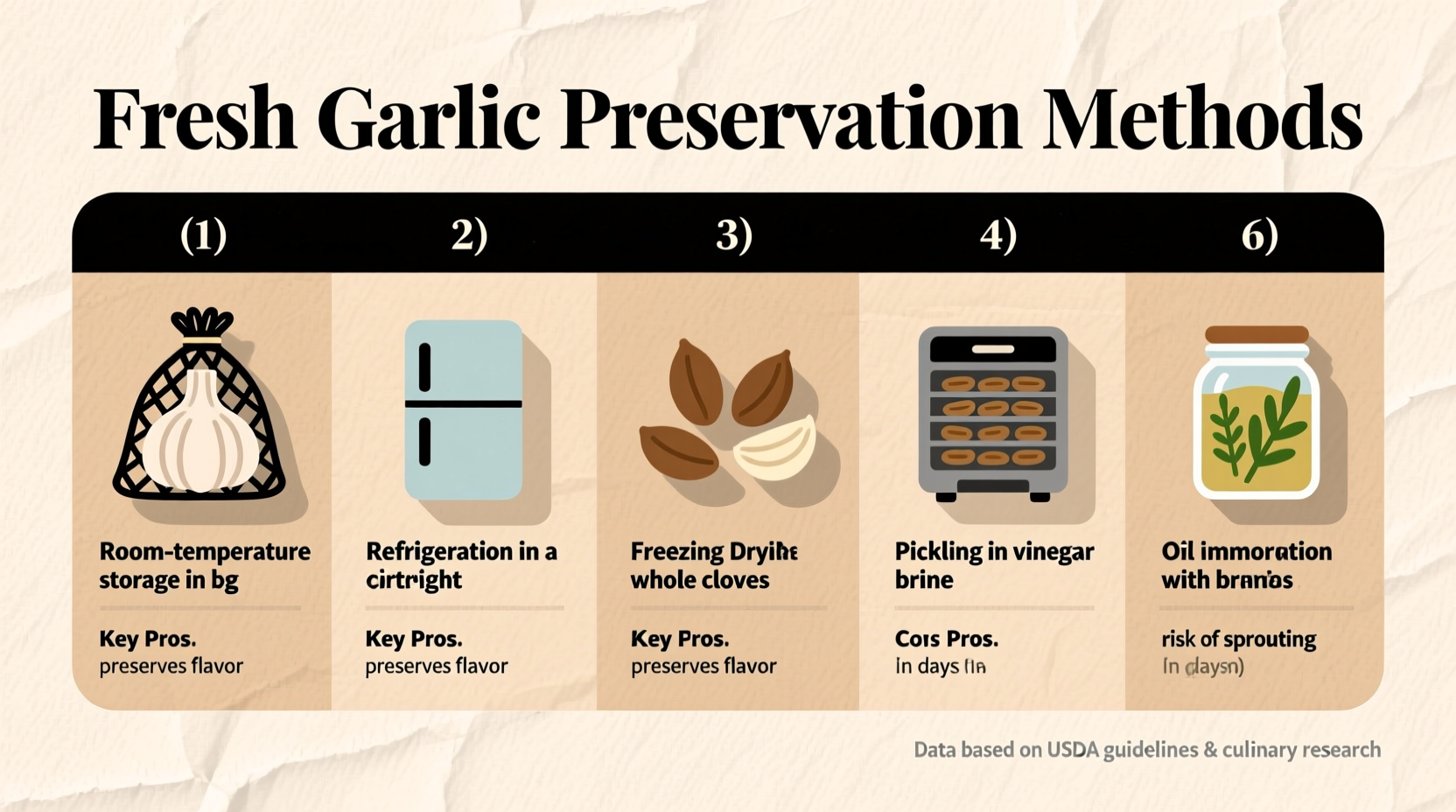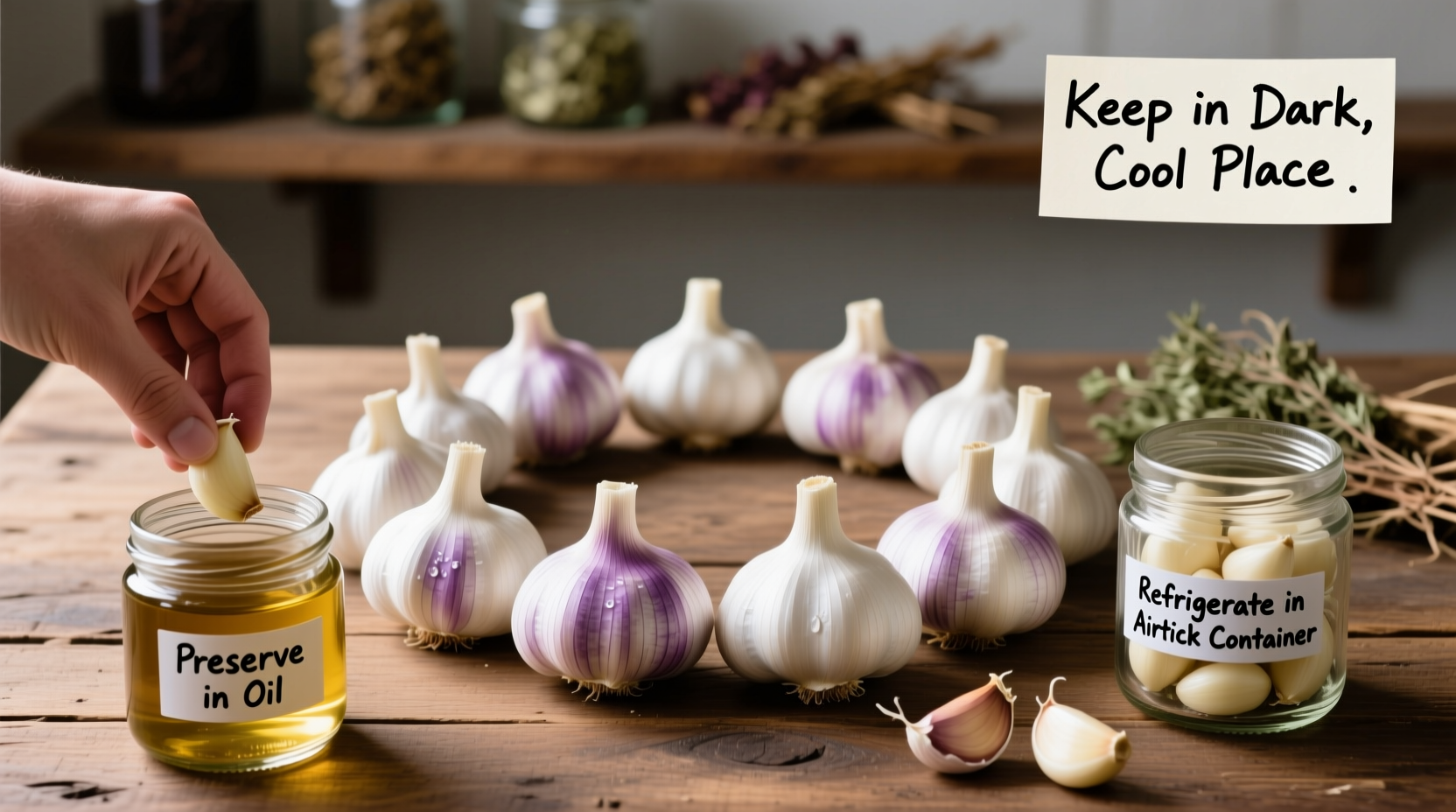Preserve fresh garlic for 3-12 months using these proven methods: store whole bulbs in a cool, dark place (3-6 months); freeze cloves in oil (6-12 months); pickle in vinegar (6+ months); dehydrate (6-12 months); make garlic powder (12+ months); or create garlic-infused oil (1-2 weeks refrigerated). Each method maintains flavor differently—choose based on your cooking needs and storage timeline.
Why Proper Garlic Preservation Matters
Garlic transforms from a humble bulb into a culinary powerhouse, but its shelf life is frustratingly short. When stored improperly, garlic sprouts, molds, or loses its pungent flavor within weeks. Understanding how to preserve fresh garlic properly ensures you always have this essential ingredient ready while maintaining its complex flavor compounds. According to the National Center for Home Food Preservation, proper storage techniques can extend garlic's usability by 300-400% compared to room temperature storage.
Step-by-Step Garlic Preservation Methods
1. Room Temperature Storage (Whole Bulbs)
This simplest method to preserve fresh garlic works best for unpeeled whole bulbs. Find a cool (60-65°F/15-18°C), dark, well-ventilated spot like a pantry or cellar. Never store garlic in the refrigerator—the humidity promotes sprouting. Place bulbs in a mesh bag, paper bag, or traditional garlic keeper with ventilation holes.
Pro tip: Keep bulbs intact until needed. Separating cloves triggers sprouting. This method maintains garlic's natural enzymes and complex flavor profile better than refrigeration.
2. Freezing Garlic (Peels On or Off)
Freezing preserves garlic's fresh flavor longer than any other home method. You have three options:
- Whole cloves: Place unpeeled cloves in freezer bags, removing excess air
- Peeled cloves: Freeze on a tray first, then transfer to containers
- Prepared garlic: Blend with oil (3 parts garlic to 1 part oil) and freeze in ice cube trays
According to USDA food safety guidelines, frozen garlic in oil maintains quality for 6-12 months when stored at 0°F (-18°C). Thaw frozen garlic cubes directly in cooking—no need to defrost first.
| Preservation Method | Shelf Life | Flavor Retention | Best For |
|---|---|---|---|
| Room Temperature (whole) | 3-6 months | Excellent | Regular cooking needs |
| Freezing (in oil) | 6-12 months | Very Good | Stews, sauces, soups |
| Pickling | 6+ months | Good (tangy) | Salads, dressings |
| Dehydrating | 6-12 months | Fair (concentrated) | Rub blends, soups |
| Garlic Powder | 12+ months | Fair (milder) | Seasoning blends |
| Infused Oil | 1-2 weeks (refrigerated) | Excellent | Finishing dishes |
3. Pickling Fresh Garlic
Pickling creates tangy, versatile preserved garlic. Use this garlic preservation technique when you have surplus bulbs:
- Peel 1 pound fresh garlic cloves
- Place in clean pint jars with 1 tsp pickling spice per jar
- Pour boiling vinegar solution (equal parts vinegar and water with 1 tbsp salt) over cloves
- Process in boiling water bath for 10 minutes
Pickled garlic develops complex flavors over 2-4 weeks. The Oregon State University Extension confirms properly processed pickled garlic remains safe for 6+ months in pantry conditions.

4. Dehydrating Garlic
Dehydration concentrates garlic's flavor while removing moisture that causes spoilage. For best results:
- Slice cloves uniformly (1/8 inch thick)
- Dehydrate at 135°F (57°C) for 8-12 hours
- Store in airtight containers with oxygen absorbers
Dehydrated garlic reconstitutes well in soups and stews. Food science research shows dehydration preserves allicin (garlic's key compound) at 70-80% of fresh levels when done properly.
5. Making Garlic Powder
Transform dehydrated garlic into versatile powder:
- Ensure dehydrated slices are completely dry (snap when bent)
- Grind in spice grinder until fine powder
- Sift through fine mesh to remove chunks
- Store in dark glass container away from light
Garlic powder lasts 12+ months and works perfectly in rubs and spice blends. Unlike commercial versions, homemade powder contains no anti-caking agents.
6. Garlic-Infused Oil (With Safety Warning)
While popular, garlic-in-oil requires strict safety protocols. The FDA warns that improperly stored garlic in oil can cause botulism. To safely make infused oil:
- Use freshly peeled cloves (never roasted)
- Refrigerate immediately after preparation
- Consume within 1-2 weeks
- Never store at room temperature
For longer storage, freeze oil cubes instead of refrigerating.
Troubleshooting Common Preservation Problems
Problem: Garlic turns blue or green during preservation
Solution: This harmless color change occurs when garlic's enzymes react with acid (in pickling) or metal. The garlic remains safe to eat—the color affects appearance only.
Problem: Sprouting in stored bulbs
Solution: Separate sprouted cloves immediately. While safe to eat, sprouted garlic has diminished flavor. Use sprouted cloves in cooked dishes where flavor intensity matters less.
Problem: Mold development
Solution: Discard any garlic showing mold. Never attempt to salvage by cutting away affected areas—mold penetrates deeper than visible. Prevent mold by ensuring proper ventilation and dry storage conditions.
Choosing Your Best Preservation Method
Your ideal fresh garlic preservation method depends on three factors:
- Cooking frequency: Daily cooks benefit from frozen cubes; occasional users prefer whole bulb storage
- Flavor needs: Pickling creates tangy notes; freezing preserves fresh flavor best
- Storage space: Dehydrated garlic takes minimal space; frozen methods require freezer capacity
Professional chefs often use multiple methods simultaneously—keeping whole bulbs for immediate use while freezing excess harvest for winter cooking.











 浙公网安备
33010002000092号
浙公网安备
33010002000092号 浙B2-20120091-4
浙B2-20120091-4